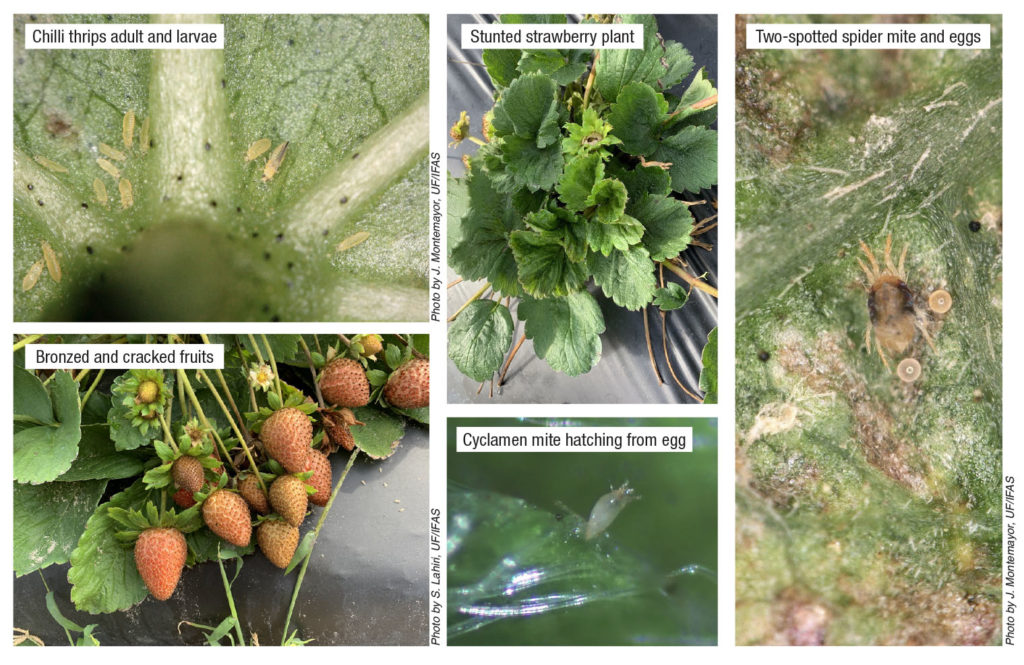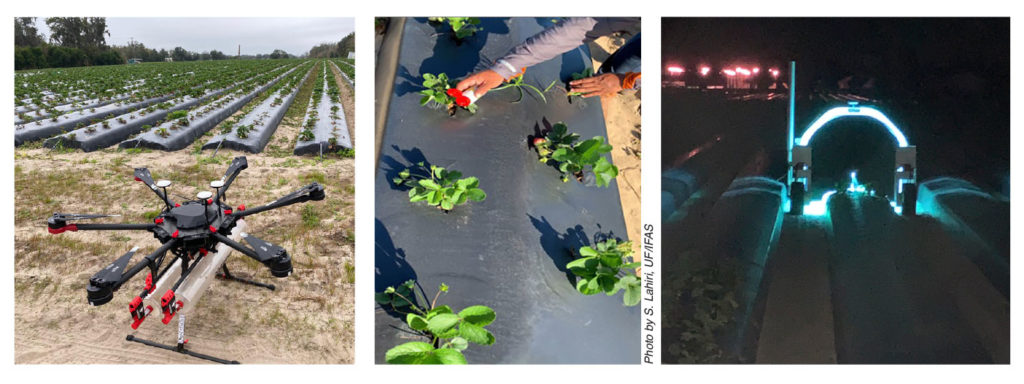
By Sriyanka Lahiri
The development of an integrated pest management (IPM) approach for the various arthropod pests of organic strawberries is underway at the University of Florida’s Strawberry and Small Fruit Crops Entomology Lab. The primary arthropod pests needing management include chilli thrips, western flower thrips, two-spotted spider mite and cyclamen mite.
Strawberry fruit yield losses due to feeding damage caused by these pests include fruit bronzing and cracking, stunted and weakened plants, reduced berry numbers and ultimately plant death (Figure 1). IPM tools — such as biological control, irradiation with ultraviolet C light and Organic Materials Review Institute (OMRI)-listed biorational pesticides — are all proving to be effective methods.

BIOLOGICAL CONTROL
Amblyseius swirskii and Neoseiulus cucumeris predatory mites were released by hand in open-field strawberry crops and found to be particularly effective in suppressing thrips larvae. Thrips larvae are notoriously difficult to control with insecticides and develop resistance rapidly. These predatory mites are generalist feeders as they can find and feed on well-hidden thrips and mite pests under the fruit calyx. In the absence of prey items, these predatory mites can sustain themselves by feeding on pollen.
The spider mite specialist predator, Phytoseiulus persimilis, is a voracious feeder on all stages of the two-spotted spider mite. P. persimilis feeds only on web-producing spider mite species and starves to death if it runs out of spider mite prey, but it is currently the most effective biological control agent of spider mites. All these species of predatory mites are commercially available and can be released by hand directly at the base of the strawberry plant or via drones (Figure 2).
PHYSICAL CONTROL
When applied appropriately, ultraviolet radiation is a high-energy electromagnetic wave that is capable of destroying the genetic material of insects and mites. Such irreparable damage to the DNA causes high rates of mortality in vulnerable life stages of these pests.
Particularly, ultraviolet C spectrum (UVC = 200-280 nanometers wavelength) is effective in killing spider mite eggs when applied after sunset. At least a four-hour dark period is necessary to prevent activation of the DNA repair mechanism present in many mites and thrips.
Two-spotted spider mite eggs suffer high mortality rates with less than 10% egg hatch, when irradiated with a high dose after sunset, as opposed to approximately 90% egg hatch in non-irradiated eggs. P. persimilis predatory mite is also able to continue feeding on spider mites even after irradiation with UVC, but the eggs of the predatory mites are highly susceptible to UVC irradiation. Therefore, spider mite control with a combination of UVC irradiation first to kill the eggs, followed by release of P. persimilis is most sustainable.
BIORATIONAL PESTICIDES
OMRI-listed biorational pesticides based on entomopathogenic nematodes, fungi and plant extracts are effective as a foliar rescue treatment in organic strawberries.
Significant adult and larval chilli thrips suppression can be achieved with two applications, one week apart, of either Steinernema feltiae or Heterorhabditis bacteriophora (entomopathogenic nematodes), Beauveria bassiana (Mycotrol ESO; entomopathogenic fungi) or neem extract (Azera; azadirachtin + pyrethrin). After a single application of capsicum-oleoresin extract (Captiva Prime), larval chilli thrips can be suppressed effectively but the same cannot be said about the adults. These biorational pesticides can be used for early-season pest control in organic strawberries to prevent establishment of thrips pests. Spinosad (Entrust) is most effective in chilli thrips adult and larval suppression for up to three weeks after application but should not be applied more than twice in a strawberry season, even with a rotation program.
Through utilization of clean transplants, biological and physical pest control, an IPM strategy can be adopted for organic strawberry production.
Sriyanka Lahiri is an assistant professor at the University of Florida Institute of Food and Agricultural Sciences Gulf Coast Research and Education Center in Wimauma.









